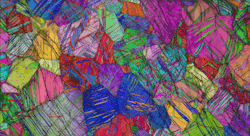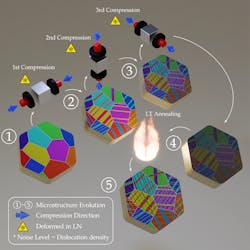Titanium is strong and light, with the highest strength-to-weight ratio of any metal. But giving it a good balance of strength and ductility is difficult and expensive. That’s why titanium is used mostly in niche applications in select industries.
To get around this trade-off, researchers at the Lawrence Berkeley National Laboratory have developed a technique called cryo-forging. It manipulates titanium at ultra-low temperatures to create extra-strong nano-twinned titanium that does not lose its ductility.
Nanotwins have an atomic arrangement in which the boundaries between grains line up symmetrically. This makes it easier for atoms in the crystalline structure to move around without building up stress while letting the metal retain its increased strength.
Nano-twinned materials are not new. However, making them typically requires specialized techniques that can be costly. These techniques work for some metals, such as copper, and are typically only used to make thin films. Thin-film properties are rarely found in bulk materials.
The mechanical properties of metals depend in part on their grains, small areas of crystals with repeating atomic patterns that form the material’s internal structure. Boundaries between grains, where the pattern changes, strengthen the metal by preventing defects (dislocations) from moving across and weakening the material’s structure.
One way to strengthen a metal is to forge it and shrink the size of its grains to create more boundaries. This forging compresses the metal at high temperatures or uses rolling and hammering at room temperature to compress it. However, forging to increase strength often comes at the expense of ductility; forging breaks up the internal structure, making it brittle and prone to fracturing.
To create nano-twinned titanium, the researchers used cryo-forging to manipulating the metal’s structure at ultra-low temperatures. They started with a cube of 99.95% pure titanium which they submerged in liquid nitrogen at −321°F. Force applied to all sides of the cube compresses it and nanotwin grain boundaries begin to form in the titanium. The cube is then heated to 750°F to remove any structural defects that may have formed between the grain boundaries.
The researchers put the newly formed version of titanium through several stress tests and used electron microscopes to see how the crystals reacted. They discovered that the nano-twinned titanium had better formability because it can create new nanotwin boundaries and undo previously formed ones, which let it resist deformation.
Tested to temperatures of 1,112°F, the material retained its structure and properties. And at super-cold temperatures, the metal withstood more strain than normal titanium, which is the opposite of what generally happens for most metals—i.e., at low temperatures, most materials become more brittle.
In the case of titanium, the researchers found that nano-twinning doubled the metal’s strength and increased its ductility by 30% at room temperature. At super-low temperatures, the improvement was even more pronounced; the nano-twinned titanium could double in length before fracturing. It also retained its high-temperatures properties. So the nano-twinned titanium should perform equally well exposed to the extreme cold of outer space or the intense heat of a jet engine.
Fabricating nano-twinned titanium using cryo-forging is potentially cost-effective, scalable for commercial production and produces an easily recycled metal. The researchers plan to try the new forging process they developed for titanium on other metals.


